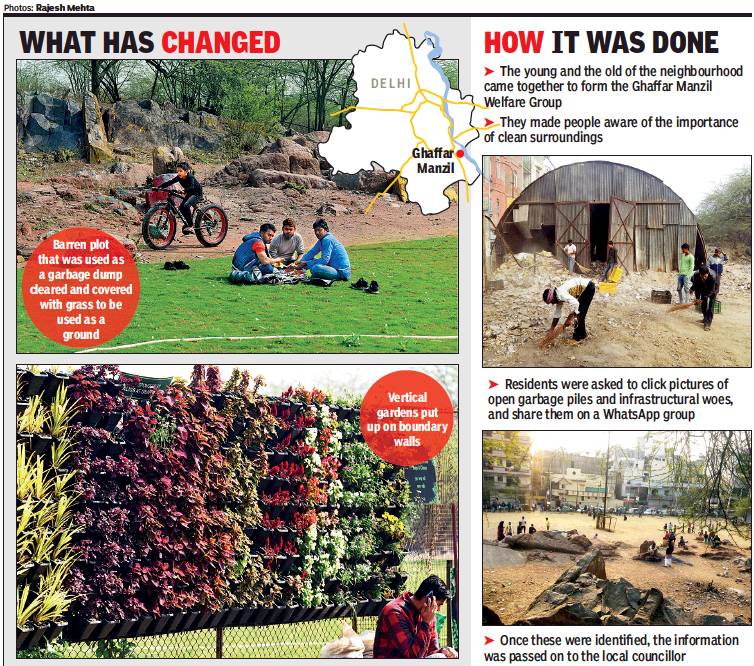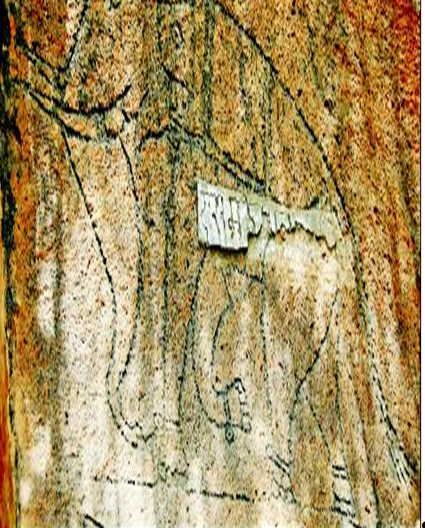Delhi: J
These are newspaper articles selected for the excellence of their content.
|
Contents |
Jama Masjid
See Delhi: Jama Masjid (Masjid Jahannuma)
Jamia Nagar
Ghaffar Manzil: waste management/ 2019
Mohammad Ibrar, April 5, 2019: The Times of India

From: Mohammad Ibrar, April 5, 2019: The Times of India
Disgusted with the garbage and the stench around, residents of Jamia Nagar’s Ghaffar Manzil took matters into their own hands to clean up their surroundings. An awareness programme was recently initiated in which residents were asked to click pictures of open garbage piles and infrastructural woes and share them on a WhatsApp group. A subsequent campaign then pushed for these to be acted upon.
“Our area had a bad reputation because there was no sense of cleanliness and the municipal services were all but absent,” said Tehreema Ahmed, a former schoolteacher. “When the filth and the garbage became too much for us, we had no option but to join hands in trying to change the place.”
The young and the old of the neighbourhood came together to form the Ghaffar Manzil Welfare Group. “We made the people aware of the importance of clean surroundings,” said Tarannum Abdullah, a designer. “We asked them to take photos of garage or filth lying unattended near their houses. Once we had identified these, we passed the information to the local councillor for him to initiate steps to rectify the problems.”
One of the tangible results of this exercise is a sorely-needed playground for the children. The people got a barren plot that was used as a garbage dump cleared and covered with grass for use as a ground. A new gate has been built and the ground is accessible to all the residents. They also cleaned up another trash heap. “Our councillor has been very supportive and assured of her support we decided to convert that spot into a green lawn,” said homemaker Nasreen Zaidi.
The people now make sure the trucks come regularly to pick up the garbage. “Currently, we are building segments and planting several plants and even vertical gardens on the boundary walls of the ground,” informed Shadab, a resident. He added that the “change on the ground proves that people can themselves achieve the change they want to see in their lives”.
The members of the welfare group themselves contributed the funds required for various activities. The awareness campaign was led by children. “It is the children who are affected the most, so it is necessary that we involve them in spreading a good message,” noted Ahmed.
JNU campus
Rock carvings, Delhi
Rock carvings unearthed at JNU, but ASI prefers to bury history
Neha Lalchandani & Richi Verma TNN
The Times of India, July 16, 2011
New Delhi: Jawaharlal Nehru University staff had discovered some ancient rock carvings on the campus in 2007 and had informed the Archaeological Survey of India. An inspection was carried out later in the year and ASI officials, who were inclinedthen tobelievethatthe carvings held promise of being an important find, were to submit a report on their carbon dating.Four years down the line, when the campus is undergoing massive changes due to construction work, ASI is yet to determine whether the findings have authentic historical significance or not.Dr Surya Prakash, who has been in touch with ASI since 2007, said that initially ASI was equally excited about the find but over the years officials stopped responding to phone calls and emails.
“First we were told that the staff was busy with Commonwealth Games preparations, but once that was over ASI started ignoring our calls. We have not heard from them,” he said. Sources said the dating was important also because there were more such historical remains likely to be found in JNU and many mightbe getting destroyedin the construction work going on in the campus.
BR Mani, joint director general ASI told TOI: “The etchings could be from the medieval times. While ASI cannot declare it of national importance because there are uncertainties about their origin, the university should definitely preserve them and ASI will be glad to assist in any matter. Some of the carvings could be new and it requires more investigation.”
Former director general of ASI Dr R C Aggarwal, who saw pictures of the carvings, said: “The engravings are definitely historical and appear to be from the medieval times.
The elephant engraving is a completefigure andis fully decorated. There should be a corresponding figure to this one as the one found looks to be in motion. This kind of style is found in forts and palaces of Rajasthan. JNU should definitely preserve these findings and display it as part of their legacy. The carvings are in granite and should be maintained by fencing or something.” Dr Aggarwal is now principal director (architectural heritage) of INTACH.
Despite repeated attempts,ASIDelhicirclechief KK Mohammad remained unavailable. ASI officials, however, said that they would ask Delhi circle to submit a report on the issue along with photographs. While the Delhi circle should have informed the headquarters of the discovery when JNU reported it in 2007, officials told them about it only earlier this week. “When the Delhi circle team visited JNU last year, they said that the findings did not have much significance and there were just one or two letters engraved in the stone.
However, we will reassess the findings to ascertain what their historical links are,” said a senior ASI official.
ASI sources said that based on historical studies, it was quite possible that JNU did have archaeological remains. Though Delhi circle of ASI appraised these etchings about four years back, officials have kept the university waiting by not making their observations official. “When the ASI team came to JNU, they agreed that the etchings could have great historical significance.
It has taken them four years to finally say that the findings are insignificant. And if that was the case why have the officials still not informed us. We had proposed removing the rock and placing it in safe custody, but ASI said that we shouldn’t move it till they have studied it properly,” said Prakash.
